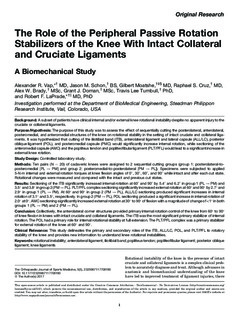The role of the peripheral passive rotation stabilizers of the knee with intact collateral and cruciate ligaments: a biomechanical study
| dc.contributor.author | Vap, Alexander R. | |
| dc.contributor.author | Schon, Jason M. | |
| dc.contributor.author | Moatshe, Gilbert | |
| dc.contributor.author | Cruz, Raphael S. | |
| dc.contributor.author | Brady, Alex W. | |
| dc.contributor.author | Dornan, Grant J. | |
| dc.contributor.author | Turnbull, Travis Lee | |
| dc.contributor.author | LaPrade, Robert F. | |
| dc.date.accessioned | 2017-10-09T09:46:04Z | |
| dc.date.available | 2017-10-09T09:46:04Z | |
| dc.date.issued | 2017-05 | |
| dc.identifier.citation | The Orthopaedic Journal of Sports Medicine. 2017, 5. doi: 10.1177/2325967117708190 | nb_NO |
| dc.identifier.uri | http://hdl.handle.net/11250/2459127 | |
| dc.description.abstract | Background: A subset of patients have clinical internal and/or external knee rotational instability despite no apparent injury to the cruciate or collateral ligaments. Purpose/Hypothesis: The purpose of this study was to assess the effect of sequentially cutting the posterolateral, anterolateral, posteromedial, and anteromedial structures of the knee on rotational stability in the setting of intact cruciate and collateral ligaments. It was hypothesized that cutting of the iliotibial band (ITB), anterolateral ligament and lateral capsule (ALL/LC), posterior oblique ligament (POL), and posteromedial capsule (PMC) would significantly increase internal rotation, while sectioning of the anteromedial capsule (AMC) and the popliteus tendon and popliteofibular ligament (PLT/PFL) would lead to a significant increase in external knee rotation. Study Design: Controlled laboratory study. Methods: Ten pairs (N = 20) of cadaveric knees were assigned to 2 sequential cutting groups (group 1: posterolateral-to-posteromedial [PL → PM] and group 2: posteromedial-to-posterolateral [PM → PL]). Specimens were subjected to applied 5-N·m internal and external rotation torques at knee flexion angles of 0°, 30°, 60°, and 90° while intact and after each cut state. Rotational changes were measured and compared with the intact and previous cut states. Results: Sectioning of the ITB significantly increased internal rotation at 60° and 90° by 5.4° and 6.2° in group 1 (PL → PM) and 3.5° and 3.8° in group 2 (PM → PL). PLT/PFL complex sectioning significantly increased external rotation at 60° and 90° by 2.7° and 2.9° in group 1 (PL → PM). At 60° and 90° in group 2 (PM → PL), ALL/LC sectioning produced significant increases in internal rotation of 3.1° and 3.5°, respectively. In group 2 (PM → PL), POL sectioning produced a significant increase in internal rotation of 2.0° at 0°. AMC sectioning significantly increased external rotation at 30° to 90° of flexion with a magnitude of change of <1° in both groups 1 (PL → PM) and 2 (PM → PL). | nb_NO |
| dc.language.iso | eng | nb_NO |
| dc.publisher | Sage | nb_NO |
| dc.subject | rotational instability | nb_NO |
| dc.subject | anterolateral ligament | nb_NO |
| dc.subject | iliotibial band | nb_NO |
| dc.subject | popliteus tendon | nb_NO |
| dc.subject | popliteofibular ligament | nb_NO |
| dc.subject | posterior oblique ligament | nb_NO |
| dc.subject | knee ligaments | nb_NO |
| dc.title | The role of the peripheral passive rotation stabilizers of the knee with intact collateral and cruciate ligaments: a biomechanical study | nb_NO |
| dc.type | Journal article | nb_NO |
| dc.type | Peer reviewed | nb_NO |
| dc.source.journal | Orthopaedic Journal of Sports Medicine (OJSM) | nb_NO |
| dc.identifier.doi | 10.1177/2325967117708190 | |
| dc.description.localcode | Seksjon for idrettsmedisinske fag / Department of Sports Medicine | nb_NO |
Tilhørende fil(er)
Denne innførselen finnes i følgende samling(er)
-
Artikler / Articles [2096]
